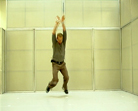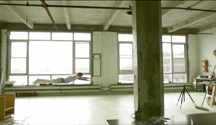May 05, 2006
MIT List Visual Arts Center

Art + Technology
Currently at the MIT List Visual Arts Center, Cambridge, Massachusetts: 9 Evenings Reconsidered: Art, Theatre, and Engineering, 1966; Choreographic Turn: Daria Martin; Peter Welz in collaboration with William Forsythe; and Chris Doyle: Recent Video Works
9 Evenings Reconsidered: Art, Theatre, and Engineering, 1966, Curator: Catherine Morris.
This exhibition, organized by independent curator Catherine Morris, takes a fresh look at 9 evenings: theatre and engineering, a series of performance events organized by Billy Klüver, a Bell Laboratories engineer, that took place at the 69th Regiment Armory in New York from October 13-23, 1966. 9 evenings featured ten artist/engineer collaborators who attempted to realize previously unattainable creative projects. 9 Evenings was a significant turning point for many artists who became aware, many for the first time, of the implications that advancements in technology had for the development of their own work. The exhibition 9 Evenings Reconsidered: Art, Theatre, and Engineering, 1966 includes works of art, ephemera, drawings, film, and photo documentation of the 1966 performances.
The artists involved in 9 evenings: theatre and engineering were John Cage (composer); Lucinda Childs (dancer and choreographer); Öyvind Fahlström (painter and author of theater pieces); Alex Hay (painter and choreographer); Deborah Hay (dancer and choreographer); Steve Paxton (dancer and choreographer); Yvonne Rainer (filmmaker, dancer and choreographer); Robert Rauschenberg (painter and choreographer); David Tudor (musician and composer); and Robert Whitman (film/video artist, author of theater pieces). Bell Laboratories’ Billy Klüver brought these artists together and paired each artist with an/a Bell Labs engineer to create new works. Engineers included: Per Biorn, Cecil Coker, Ralph Flynn, Larry Heilos, Peter Hirsch, Harold Hodges, Robert Keronski, Jim McGee, Robby Robinson, Herb Schneider (MIT Class of 1948), Fred Waldhauer, Witt Wittnebert, and Dick Wolff.

Choreographic Turn: Daria Martin; Peter Welz in collaboration with William Forsythe, Curator: Bill Arning, MIT List Visual Arts Center.
This exhibition features a 16mm film entitled Soft Materials by Daria Martin, an American artist living and working in London, and a large five-screen video installation entitled whenever on on on nohow on / airdrawing by German artist Peter Welz in collaboration with celebrated dancer/choreographer William Forsythe. In bringing together the work of these artists, curator Bill Arning offers audiences the opportunity to consider the space between dance and moving image in contemporary art practice. There is a growing history and cultural practice of choreocinema, or dance on film/video, a hybrid art form that offers previously unavailable experiences of dance. Choreographic Turn celebrates this exciting shift in cultural practice by showing two recent extraordinary iterations of this new form-film/video installations offering new modes of experiencing the art of bodies in motion.

Chris Doyle: Recent Video Works
Flight (2005) 31 seconds
Tower (2005) 4 minutes
Hotel Bernini I (excerpt) (2004) 2 minutes, 33 seconds
Watershed (2004) 3 minutes, 02 seconds
Extraordinary Perceptual Dilemmas and the Madness of Climbing (2003) 1 minute, 30 seconds
Chris Doyle's themes are drawn from the psychology of everyday life. By using only the most low-tech special effects, he transforms everyday images into short films that are magical and moving.
Doyle is perhaps best known for Leap , a public artwork sponsored by Creative Time in April, 2000, for New York City's 2 Columbus Circle. A celebration of hope, Leap , showed moving images projected onto a tall building of various New Yorkers from all five boroughs jumping skyward. Beginning at dusk, depictions of a continuous stream of New Yorkers appeared at the base of the building, and one by one, four hundred and twenty jumpers soared up the height of the facade, slipping into the night sky.
In recent years, Doyle has worked less in the public sphere, and more in the private fictional spaces he creates in his videos. This selection of videos shows a wide range of Doyle's interests, but each manifests a dreamlike vision in which the quotidian becomes extraordinary. Doyle likens his practice to a "Pathetic Magician, a sad sack trying to make magic out of what is at hand."1 Writing in Art News magazine Linda Yablonsky said "(Doyle) has cast hot dogs, red bricks, and lawn chairs as human surrogates in videos that constantly mix storytelling with abstraction." 2
Flight (2005) shows the artist doing aerial circuits in a Superman pose around his Brooklyn studio before heading out the window. Today, when even amateurs have access to Hollywood-quality special effects, the artist's goal is clearly not a seamless effect. The jerky motion is left as a clue to his methodology, in which the artist performed 230 individual leaps and then sequenced the still photographs to depict flight.
Tower (2005) uses an animation technique known as "claymation". Doyle has turned the descriptive form upside down; and we see the effects of unseen artist's hands on the tower, wounding and suturing the form. and twisting it like taffy.
Hotel Bernini I (2004) is among Doyle's most evocative works, in that how one perceives the turbulence of the white hotel sheets will invariably be affected by one's own psychology. Whether it is understood as the result of anxiety, insomnia, or passion, the sheets are now vacant, and the bodies that gave them life are now missing.
Watershed (2004) shows a partly deconstructed bank building that the artist found in upstate New York. Using only flashlights for special effects, Doyle uses the skeletal frame as a metaphor for the psychological structures that contain thought, with the flashes of light serving as the events or perceptions that define human relationships. The artist appears at the very end sweeping up after the emotional fireworks.
Extraordinary Perceptual Dilemmas and the Madness of Climbing (2003) was a site specific project done for an exhibition in East Hampton, Long Island, NY. Like many natural paradises that have become popular resorts, longtime residents describe the area's past in idyllic terms that are too dreamy to be true. The old movie feel and the slightly horrific over-profusion of images are meant to conjure the dark side of paradise.
Posted by jo at May 5, 2006 10:51 AM
